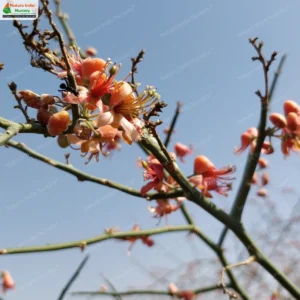Canthium coromandelicum, commonly known as Coromandel Canthium, Coromandel Boxwood, or by various regional names such as Kirma (Marathi), Nallakkarai (Tamil), Kantankara (Malayalam), and Nagabala (Sanskrit), is a shrub or small tree in the Rubiaceae (coffee) family. Native to South India, Sri Lanka, Nepal, and Bangladesh, this species is notable for its resilience, medicinal value, and ornamental appeal.
The plant is typically an armed shrub, with opposite, horizontal thorns just above the leaf axils, though some specimens may be nearly thornless. Leaves are ovate, smooth, and often clustered on young shoots. The flowers are small, greenish-yellow, and appear in short, few-flowered racemes or cymes in the leaf axils. The fruit is a globose drupe, orange or yellow when ripe, and is characteristically furrowed on each side.
Habitat
Canthium coromandelicum thrives in scrub jungles and plains from coastal regions up to elevations of 750–1000 meters. It is commonly found in India (especially Kerala, Tamil Nadu, and other southern states), Indo-China, West and South China, and Malaysia. The species prefers well-drained soils and is adapted to the wet tropical biome but can also tolerate drier scrub conditions.
Planting and Care
- Light: Prefers bright, filtered sunlight but is adaptable to full sun.
- Soil: Requires well-drained soil. It can tolerate a range of soil types but does best in sandy or loamy substrates.
- Watering: Maintain consistent moisture, allowing the soil to slightly dry out between waterings. Avoid waterlogging to prevent root rot.
- Fertilization: Regular fertilization during the growing season supports vigorous growth and fruit production.
- Maintenance: Occasional pruning helps maintain shape and remove any dead or diseased branches. The plant can be propagated by both seeds and cuttings
Additional Information
- Ornamental Use: Coromandel Canthium is valued for its glossy foliage, thorny branches, and bright orange-yellow berries, making it a striking addition to hedges, borders, and naturalized gardens.
- Medicinal Properties: Traditionally, various parts of the plant have been used in Indian medicine and Ayurveda. The leaves, roots, and fruits are reputed for their astringent, diuretic, and tonic properties. Extracts have been used for wound healing, treating skin ailments, and as a general tonic. Phytochemical studies have identified compounds such as phytol, sitosterol, gallic acid, and quercetin, which may contribute to its pharmacological activities.
Canthium coromandelicum is a resilient and attractive shrub, offering both ornamental beauty and traditional medicinal benefits, making it a valuable addition to gardens and landscapes in its native regions.













